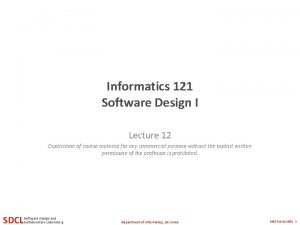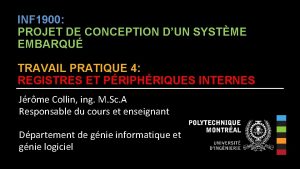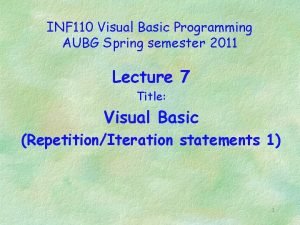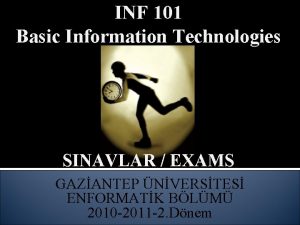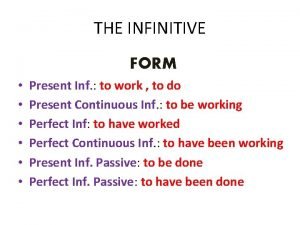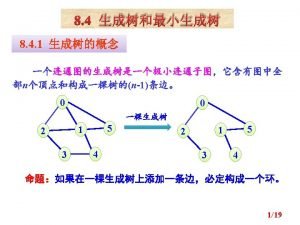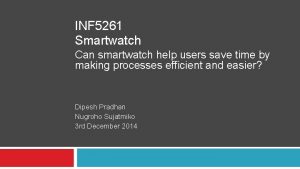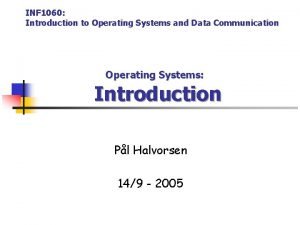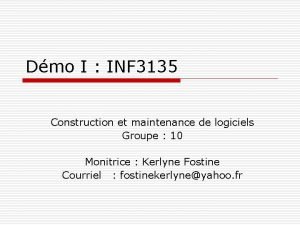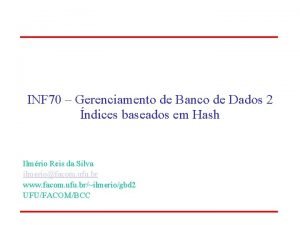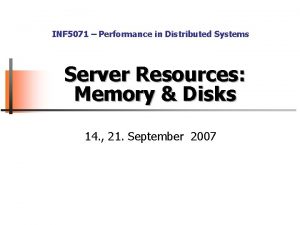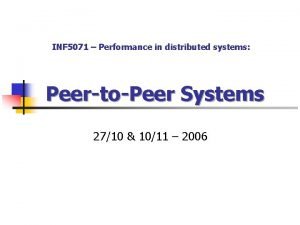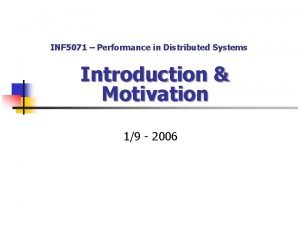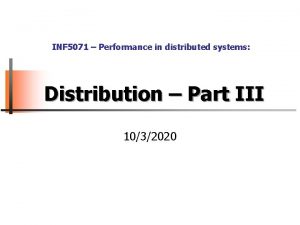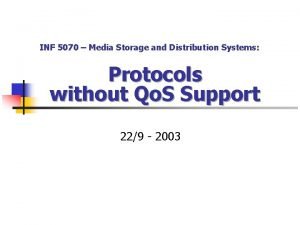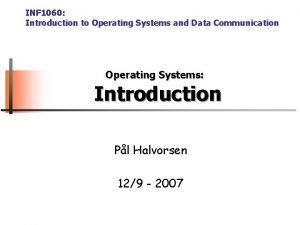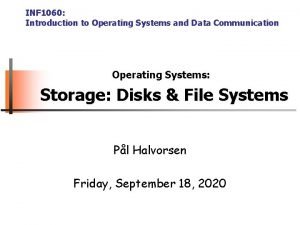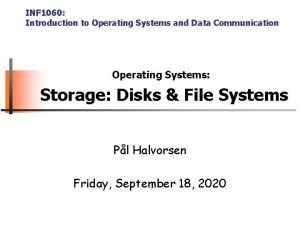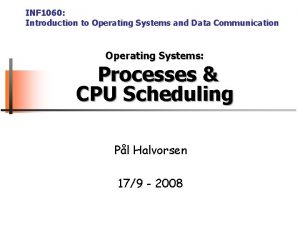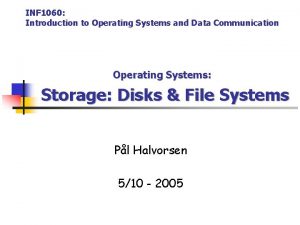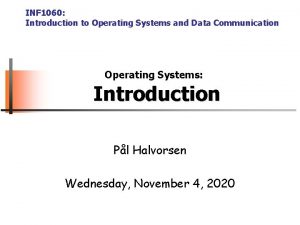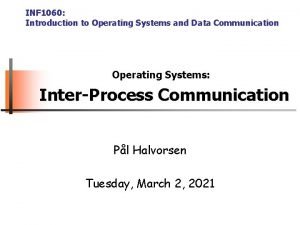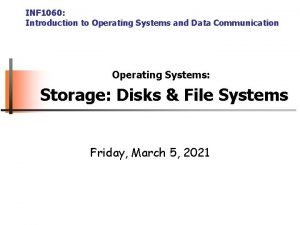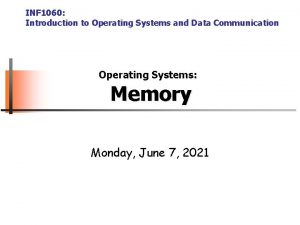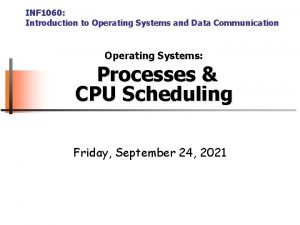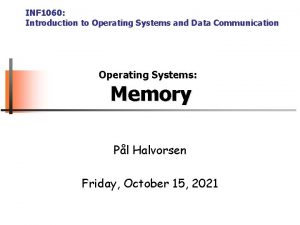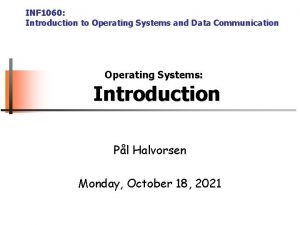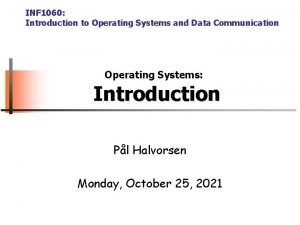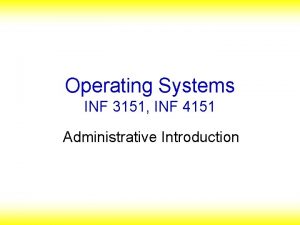INF 1060 Introduction to Operating Systems and Data




![What we want Client Server <necessary includes> int main() { char buf[13]; <Declare some What we want Client Server <necessary includes> int main() { char buf[13]; <Declare some](https://slidetodoc.com/presentation_image/4f4fe0c76aa9a67c274226ccba271265/image-5.jpg)






























- Slides: 35

INF 1060: Introduction to Operating Systems and Data Communication: Introduction to Berkeley Sockets Pål Halvorsen (adapted from lectures by Carsten Griwodz & Olav Lysne)

Big Picture Machine 1 Machine 2 process A process B network University of Oslo INF 1060, Autumn 2007, Pål Halvorsen

Goal § Introduce socket API § We will write two programs − A “client” and a “server” § Each will run on one machine − the server will run on “kaksi. ifi. uio. no” (129. 240. 65. 193) § They will work as follows − − The The University of Oslo client sends the text “Hello world!” to the server will write the received text on the screen server sends the received text back to the client and quits client writes the received text onto the screen and quits INF 1060, Autumn 2007, Pål Halvorsen

What we want Machine 1 Machine kaksi. ifi. uio. no client server Hello world! network Hello world! University of Oslo INF 1060, Autumn 2007, Pål Halvorsen
![What we want Client Server necessary includes int main char buf13 Declare some What we want Client Server <necessary includes> int main() { char buf[13]; <Declare some](https://slidetodoc.com/presentation_image/4f4fe0c76aa9a67c274226ccba271265/image-5.jpg)
What we want Client Server <necessary includes> int main() { char buf[13]; <Declare some more data structures> <Create a socket called “sock”> <Identify the server that you want to contact> <Connect to the server> int main() { char buf[13]; <declare some more data structures> <create a socket called “request-sock”> <Define how the client can connect> <Wait for a connection, and create a new socket “sock” for that connection> <Identify the server that you want to contact> /* Send data */ write(sock, “Hello world!”, 12); /* read data from the sock and write it to the screen */ read(sock, buf, 12); buf[12] = ‘�’; printf(“%sn”, buf ); /* Read data from the socket */ read(sock, buf, 12); /* Add a string termination sign, and write to the screen. */ buf[12] = ‘�’; printf(“%sn”, buf); /* send data back over the connection */ write(sock, buf, 12); <Closing code> } University of Oslo <Closing code> } INF 1060, Autumn 2007, Pål Halvorsen

Read & Write § Same functions used for files etc. § The call read(sock, buffer, n); − Reads n characters − From socket sock − Stores them in the character array buffer § The call write(sock, buffer, n); − Writes n characters − From character array buffer − To the socket sock University of Oslo INF 1060, Autumn 2007, Pål Halvorsen

Alternatives to Read & Write § The call recv(sock, buffer, n, flags); − Reads n characters − From socket sock − Stores them in the character array buffer − Flags, normally just 0, but e. g. , MSG_DONTWAIT § The call send(sock, buffer, n, flags); − Writes n characters − From character array buffer − To the socket sock − Flags University of Oslo INF 1060, Autumn 2007, Pål Halvorsen

Creation of a connection § One side must be the active one − take the initiative in creating the connection − this side is called the client § The other side must be passive − it is prepared for accepting connections − waits for someone else to take initiative for creating a connection − this side is called the server § This use of the words client and server is not entirely consistent with everyday use, but for programming this is conventional University of Oslo INF 1060, Autumn 2007, Pål Halvorsen

Special for the server side § In case of TCP − one socket on the server side is dedicated to waiting for a connection − for each client that takes the initiative, a separate socket on the server side is created − this is useful for all servers that must be able to serve several clients concurrently (web servers, mail servers) University of Oslo INF 1060, Autumn 2007, Pål Halvorsen

To do – slightly more details Client Server <Necessary includes> int main() { char buf[13]; <Declare some more data structures> <Create a socket called “sock”> <Identify the server that you want to contact> <Connect to the server> int main() { char buf[13]; <Declare some more data structures> <Create a socket called “request-sock”> <Define how the client can connect> <Wait for a connection, and create a new socket “sock” for that connection> /* Send data */ write(sock, “Hello world!”, 12); /* read data from the sock and write it to the screen */ read(sock, buf, 12); buf[12] = ‘�’; printf(“%sn”, buf ); /* Read data from the socket */ read(sock, buf, 12); /* Add a string termination sign, and write to the screen. */ buf[12] = ‘�’; printf(“%sn”, buf); /* send data back over the connection */ write(sock, buf, 12); <Closing code> } University of Oslo <Closing code> } INF 1060, Autumn 2007, Pål Halvorsen

<Necessary includes> #include #include <netinet/in. h> <sys/socket. h> <netdb. h> <stdio. h> <string. h> prototypes & defines (htons, etc. ) Ø sockaddr_in Ø prototypes (send, connect, etc. ) Ø Ø defines prototypes (gethostbyame, etc. ) Ø prototypes (printf, etc. ) Ø prototypes (bzero, etc. ) Ø § These five files are needed by both client and server § They include definitions and declarations as described on the following sides § Some systems will have the same declarations in different files – the above examples should work at IFI (see /usr/include on Linux & Solaris) University of Oslo INF 1060, Autumn 2007, Pål Halvorsen

<Create a socket> Server Client /* declarations */ int sock; /* declarations */ int request_sock; /* creation of the socket */ sock = socket(PF_INET, SOCK_STREAM, IPPROTO_TCP); /* creation of the socket */ request_sock = socket(PF_INET, SOCK_STREAM, IPPROTO_TCP); § Call to the function socket() creates a transport control block (hidden in kernel), and returns a reference to it (integer used as index) sock user kernel control block University of Oslo INF 1060, Autumn 2007, Pål Halvorsen

More about the socket call sock = socket(int domain, int type, int protocol) § PF_INET, SOCK_STREAM and IPPROTO_TCP are constants that are defined in the included files − <bits/socket. h> which is included by <sys/socket. h> − <netinet/in. h> § The use of the constants that we used on the previous slides (and above) creates a TCP/IP socket § Many other possibilities exist − Domain: PF_UNIX, PF_INET 6, … − Type: SOCK_STREAM, SOCK_DGRAM, … − Protocol: IPPROTO_TCP, IPPROTO_UDP, … University of Oslo INF 1060, Autumn 2007, Pål Halvorsen

How to identify clients to accept, and servers to contact? § Machine? ? − by its IP address (e. g. , 129. 249. 65. 193) § Application/service/program? ? − by (IP address and) port number − standard applications have own, “well-known” port numbers • SSH: 22 • Mail: 25 • Web: 80 • Look in /etc/services for more University of Oslo INF 1060, Autumn 2007, Pål Halvorsen

Address structure § struct sockaddr_in : − sin_family address family used − sin_port 16 -bit transport number − sin_addr 32 -bit IP address defined as a new structure in_addr having one s_addr element only − sin_zero padding − declared in <netinet/in. h> § Defines IP address and port number in a way the Berkeley socket API needs it University of Oslo INF 1060, Autumn 2007, Pål Halvorsen

Address structure Server Client /* declaration */ struct sockaddr_in serveraddr; /* clear the structure */ bzero(&serveraddr, sizeof(struct sockaddr_in)); /* This will be an address of the * Internet family */ serveraddr. sin_family = AF_INET; /* Add the server address – kaksi */ inet_pton(AF_INET, “ 129. 240. 65. 193”, &serveraddr. sin_addr); /* Allow all own addresses to receive */ serveraddr. sin_addr. s_addr = INADDR_ANY; /* Add the port number */ serveraddr. sin_port = htons(2009); inet_pton() is new for IPv 6 and may not exist yet. Oldest: serveraddr. sin_addr. s_addr = inet_addr(“ 129. 240. 65. 193”); Newer: inet_aton(“ 129. 240. 65. 193”, &serveraddr. sin_addr); University of Oslo INF 1060, Autumn 2007, Pål Halvorsen

Address structure § Fill address type (“family”), address and port number into the structure − serveraddr. sin_family = AF_INET; − serveraddr. sin_addr. s_addr = INADDR_ANY; (@ server) − inet_pton( AF_INET, “ 129. 240. 65. 193”, &serveraddr. sin_addr ); (@ client) − serveraddr. sin_port = htons( 2009 ); − AF_INET • a constant indicating that Internet protocols will be used − INADDR_ANY • a constant meaning any (Internet) address • in this context: any own Internet address University of Oslo INF 1060, Autumn 2007, Pål Halvorsen

Byte Order § Different machines may have different representation of multi-byte values § Consider a 16 -bit integer: made up of 2 bytes increasing memory addresses address A+1 address A high-order byte low-order byte MSB 16 -bit value LSB high-order byte low-order byte address A University of Oslo little-endian byte order address A+1 INF 1060, Autumn 2007, Pål Halvorsen big-endian byte order

Byte Order: IP address example § IPv 4 host address: represents a 32 -bit address − written on paper (”dotted decimal notation”): 129. 240. 71. 213 − binary in bits: 10000001 11110000 01000111 10001011 − hexadecimal in bytes: 0 x 81 0 xf 0 0 x 47 0 x 8 b § Little-endian: − one 4 byte int on x 86, Strong. ARM, XScale, …: 0 x 81 f 0478 b § Big-endian: − one 4 byte int on Power. PC, POWER, Sparc, …: 0 x 8 b 47 f 081 − in network byte order: 0 x 8 b 47 f 081 University of Oslo INF 1060, Autumn 2007, Pål Halvorsen

Byte Order: Translation § Byte order translation makes the communication over several platforms possible § htons() / htonl() − host-to-network short / long − translate a 16 / 32 -bit integer value to network format § ntohs() / ntohl() − network-to-host short/long − translate a 16 / 32 -bit integer value to host format § Little-endian (x 86 etc. ): ntohl(0 x 81 f 0478 b) == 0 x 8 b 47 f 081 § Big-endian (Power. PC etc. ): ntohl(0 x 81 f 0478 b) == 0 x 81 f 0478 b University of Oslo INF 1060, Autumn 2007, Pål Halvorsen

Presentation and Numeric Address Formats § The network… − …does not interpret the “dotted decimal notation” presentation format − …needs a numeric binary format in network byte order § inet_pton() − translate the text string to a numeric binary format needed by the address structure § inet_ntop() − translate the (numeric binary) network address structure to a text string University of Oslo INF 1060, Autumn 2007, Pål Halvorsen

How far have we gotten now? Client <Necessary includes> Server <Necessary includes> int main() { char buf[13]; <Declare some more data structures> <Create a socket called “sock”> <Identify the server that you want to contact> <Connect to the server> int main() { char buf[13]; <Declare some more data structures> <Create a socket called “request-sock”> <Define how the client can connect> <Wait for a connection, and create a new socket “sock” for that connection> /* Send data */ write(sock, “Hello world!”, 12); /* read data from the sock and write it to the screen */ read(sock, buf, 12); buf[12] = ‘�’; printf(“%sn”, buf ); /* Read data from the socket */ read(sock, buf, 12); /* Add a string termination sign, and write to the screen. */ buf[12] = ‘�’; printf(“%sn”, buf); /* send data back over the connection */ write(sock, buf, 12); <Closing code> } University of Oslo <Closing code> } INF 1060, Autumn 2007, Pål Halvorsen

Binding, Listening, Accepting and Connecting Client Server /* Bind the address to the socket */ bind(request_sock, (struct sockaddr*)&serveraddr, sizeof(struct sockaddr_in); /* Connect */ connect(sock, (struct sockaddr*)&serveraddr, sizeof(struct sockaddr_in)); /* Activate listening on the socket */ listen(request_sock, SOMAXCONN); /* Wait for connection */ clientaddrlen = sizeof(struct sockaddr_in); sock = accept(request_sock, (struct sockaddr*)&clientaddr, &clientaddrlen); University of Oslo INF 1060, Autumn 2007, Pål Halvorsen

Some details about the previous slides § bind(int sfd, struct sockaddr *a, socklen_t al) − a machine can have several addresses (several network cards, loopback, …) − tells the socket on the server side which local protocol (i. e. , IP address and port number) to listen to § listen( int sfd, int backlog ) − prepares the server for listening to connect requests, and initializes a queue for connect requests ( passive) − the second parameter (SOMAXCONN) defines how long the queue(s) should be University of Oslo INF 1060, Autumn 2007, Pål Halvorsen

More details § sock = accept(int sfd, struct sockaddr *a, socklen_t *al) − take the first connect request from the connect request queue − wait for the connect request to arrive if the queue is empty − returns a new socket that the server can use to communicate with the client − a (clientaddr) contains information about the client − al must be initialized, so accept knows size of a § connect(int sfd, struct sockaddr *serv_a, socklen_t al) − connects client socket to a server that is specified in the address structure − a three-way handshake is initiated for TCP − possible errors • ETIMEDOUT – no response (after several tries) and timer expired • ECONNREFUSED – server not running or not allowed to connect • EHOSTUNREACH – HOST not reachable • ENETUNREACH – NET not reachable University of Oslo INF 1060, Autumn 2007, Pål Halvorsen

Closing of Sockets Client Server /* Close the socket */ close(sock); /* Close both sockets */ close(sock); close(request_sock); § Note that the semantics of close depends − On the kind of protocol − Some possible extra settings § All data that has not been read yet may be thrown away University of Oslo INF 1060, Autumn 2007, Pål Halvorsen

Complete Client #include #include Client ctd. <netinet/in. h> <sys/socket. h> <netdb. h> <stdio. h> <string. h> /* Add IP address of kaksi. ifi. uio. no */ inet_pton(AF_INET, “ 129. 240. 65. 193”, &serveraddr. sin_addr); /* Add the port number */ serveraddr. sin_port = htons(2009); int main() { /* Declarations */ struct sockaddr_in serveraddr; int sock; char buf[13]; /* Connect */ connect(sock, (struct sockaddr*)&serveraddr, sizeof(struct sockaddr_in)); /* Send data */ write(sock, “Hello world!”, 12 ); /* Create socket */ sock = socket(PF_INET, SOCK_STREAM, IPPROTO_TCP); /* Read data */ read(sock, buf, 12 ); /* add string end sign, write to screen*/ buf[12] = ‘�’; printf(“%sn”, buf); /* Clear address structure */ bzero(&serveraddr, sizeof(struct sockaddr_in)); /* Add address family */ serveraddr. sin_family = AF_INET; University of Oslo /* Close socket */ close(sock); } INF 1060, Autumn 2007, Pål Halvorsen

Complete Server #include #include Server ctd. <netinet/in. h> <sys/socket. h> <netdb. h> <stdio. h> <string. h> /* Bind address to socket */ bind(request_sock, (struct sockaddr*)&serveraddr, sizeof(struct sockaddr_in)); /* Activate connect request queue */ listen(request_sock, SOMAXCONN); int main() { /* Declarations */ struct sockaddr_in serveraddr; struct sockaddr_in clientaddr; int clientaddrlen; int request_sock, sock; char buf[13]; /* Receive connection */ clientaddrlen = sizeof(struct sockaddr_in); sock = accept(request_sock, (struct sockaddr*)&clientaddr, &clientaddrlen); /* Create socket */ request_sock = socket(PF_INET, SOCK_STREAM, IPPROTO_TCP); /* Read data from socket and write it */ read(sock, buf, 12); buf[12] = ‘�’; printf(“%sn”, buf); /* Fill in the address structure */ bzero(&serveraddr, sizeof(struct sockaddr_in)); serveraddr. sin_family = AF_INET; serveraddr. sin_addr. s_addr = INADDR_ANY; serveraddr. sin_port = htons(2009); /* Send data back over connection */ write(sock, buf, 12); University of Oslo /*Close sockets */ close(sock); close(request_sock); } INF 1060, Autumn 2007, Pål Halvorsen

Summary of Socket Functions for our Elementary TCP Client-Server socket() bind() Client socket() listen() accept() ction conne t shmen establi read() send data: ” “hello world write() send back received da ta: “hello world” close() University of Oslo connect() write() read() close() INF 1060, Autumn 2007, Pål Halvorsen

Compilation of socket programs § The example can be downloaded from the web pages (http: //www. ifi. uio. no/~inf 1060/programs/client-server-example) § IFI’s Linux machines − gcc client 1. c –o client § IFI’s Solaris machines − gcc client 1. c –o client –lsocket –lnsl § Cygwin on Windows − gcc client 1. c –o client § Similar for server 1. c § For testing, run server on kaksi (or change the address in the client) and start client on another machine University of Oslo INF 1060, Autumn 2007, Pål Halvorsen

Complete Server ctd. . /* Receive connection */ sock = accept(. . . ); int main() { /* Declarations */. . . /* Process. . . the request*/ /*Close sockets */ close(sock); /* Create socket */ request_sock = socket(. . . ); /* Fill in the address structure */. . . /* Bind address to socket */ bind(. . . ); /* Activate connect request queue */ listen(. . . ); close(request_sock); } Iterative servers? University of Oslo INF 1060, Autumn 2007, Pål Halvorsen

Iterative Servers Server ctd. . for (; ; ) { /* Receive connection */ sock = accept(. . . ); int main() { /* Declarations */. . . /* Process. . . the request*/ /* Create socket */ request_sock = socket(. . . ); /* Fill in the address structure */. . . /* Bind address to socket */ bind(. . . ); /*Close sockets */ close(sock); /* Activate connect request queue */ listen(. . . ); } close(request_sock); } Concurrent servers? University of Oslo INF 1060, Autumn 2007, Pål Halvorsen

Concurrent Iterative Servers Server ctd. . for (; ; ) { /* Receive connection */ sock = accept(. . . ); int main() { /* Declarations */. . . pid_t pid; if ((pid = fork()) == 0) { close(request_sock); /* Process the request*/. . . /* Create socket */ request_sock = socket(. . . ); /*Close sockets */ close(sock); exit(0) /* Fill in the address structure */. . . } /* Bind address to socket */ bind(. . . ); /*Close sockets */ close(sock); /* Activate connect request queue */ listen(. . . ); } close(request_sock); } University of Oslo INF 1060, Autumn 2007, Pål Halvorsen

Summary § A short program where two processes communicate over a network § Next: the magic of how data is sent… University of Oslo INF 1060, Autumn 2007, Pål Halvorsen

Literature § “Berkeley UNIX System Calls and Interprocess Communication”, Lawrence Besaw, University of Wisconsin − is available through the course web pages § Many books: − Kurose/Ross, “Computer Networking: A Top-Down Approach Featuring the Internet”, 2 nd ed. , Addison-Wesley − Andrew Tanenbaum, “Computer Networks”, 4 th ed. , Prentice Hall − W. Richard Stevens, “Unix Network Programming – Networking APIs: Sockets and XTI”, volume 1, 2 nd ed. , Prentice Hall University of Oslo INF 1060, Autumn 2007, Pål Halvorsen
 Thomas nedorost ucf
Thomas nedorost ucf Chemsheets group 2 questions answers
Chemsheets group 2 questions answers England in 1060
England in 1060 What is dual mode in os
What is dual mode in os Inf and gerund
Inf and gerund Mulliken symbols
Mulliken symbols In4matx 121
In4matx 121 Inf1900
Inf1900 Mag inf
Mag inf Posterior circulation
Posterior circulation Artere thyroidienne inf
Artere thyroidienne inf Ma infinitiiv
Ma infinitiiv Inf 110
Inf 110 Enformatik sınav soruları
Enformatik sınav soruları Inf 327
Inf 327 Inf
Inf Present inf
Present inf Define:inf
Define:inf Www.inf
Www.inf Manifestversion
Manifestversion Centorovi kriteriji
Centorovi kriteriji Inf smartwatch
Inf smartwatch Cpu.inf
Cpu.inf Inf3135
Inf3135 Inf hartsol
Inf hartsol Autonomn
Autonomn Conjugata vera anatomica
Conjugata vera anatomica Inf
Inf Inf-schule lösungen scratch
Inf-schule lösungen scratch Verb + inf
Verb + inf Inf 70
Inf 70 Inf
Inf Hash160 to address
Hash160 to address Inf
Inf Torrent 1331x
Torrent 1331x Inf
Inf






